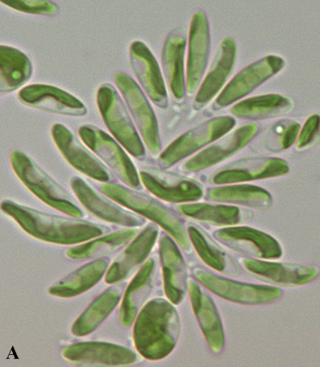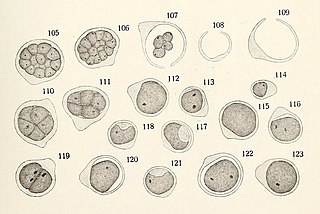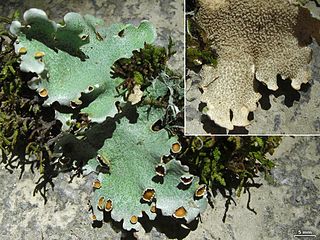
Chlorophyta is a taxon of green algae informally called chlorophytes. The name is used in two very different senses, so care is needed to determine the use by a particular author. In older classification systems, it is a highly paraphyletic group of all the green algae within the green plants (Viridiplantae) and thus includes about 7,000 species of mostly aquatic photosynthetic eukaryotic organisms. In newer classifications, it is the sister clade of the streptophytes/charophytes. The clade Streptophyta consists of the Charophyta in which the Embryophyta emerged. In this latter sense the Chlorophyta includes only about 4,300 species. About 90% of all known species live in freshwater. Like the land plants, green algae contain chlorophyll a and chlorophyll b and store food as starch in their plastids.

Beginning in 1867, a lichen was understood as a symbiosis of an algae or cyanobacteria, living among filaments of multiple fungi species. In 2016, new research by T. Spribille et al. revealed a third partner, a yeast imbedded in the lichen cortex or "skin."

The green algae are a group of chlorophyll-containing autotrophic eukaryotes consisting of the phylum Prasinodermophyta and its unnamed sister group that contains the Chlorophyta and Charophyta/Streptophyta. The land plants (Embryophytes) have emerged deep in the Charophyte alga as a sister of the Zygnematophyceae. Since the realization that the Embryophytes emerged within the green algae, some authors are starting to include them. The completed clade that includes both green algae and embryophytes is monophyletic and is referred to as the clade Viridiplantae and as the kingdom Plantae. The green algae include unicellular and colonial flagellates, most with two flagella per cell, as well as various colonial, coccoid and filamentous forms, and macroscopic, multicellular seaweeds. There are about 22,000 species of green algae, many of which live most of their lives as single cells, while other species form coenobia (colonies), long filaments, or highly differentiated macroscopic seaweeds.
Ostreococcus is a genus of unicellular coccoid or spherically shaped green algae belonging to the class Mamiellophyceae. It includes prominent members of the global picoplankton community, which plays a central role in the oceanic carbon cycle.

The Trebouxiophyceae are a class of green algae, in the division Chlorophyta. Their circumscription within the green algae is not well established due to the need for more genetic studies at higher levels within the group.
Dictyochloropsis is a genus of unicellular green alga of the phylum Chlorophyta. This genus consists of free-living algae which have a reticulate (net-like) chloroplast that varies slightly in morphology between species, and that when mature always lacks a pyrenoid. Dictyochloropsis is asexual and reproduces using autospores.

Trebouxia is a unicellular green alga. It is a photosynthetic organism that can exist in almost all habitats found in polar, tropical, and temperate regions. It can either exist in a symbiotic relationship with fungi in the form of lichen or it can survive independently as a free-living organism alone or in colonies. Trebouxia is the most common photobiont in extant lichens. It is a primary producer of marine, freshwater and terrestrial ecosystems. It uses carotenoids and chlorophyll a and b to harvest energy from the sun and provide nutrients to various animals and insects.

Coccomyxa is a genus of green algae in the family Coccomyxaceae. This genus is defined by their small, elliptical to spherical shape, and the presence of a simple parietal chloroplast. These features, along with their occurrence in various lifestyles such as free-living, parasitic, or as photobionts, have been used to identify more than 40 species. Using additional morphological features, such as brown akinetes formation, allows for the differentiation between Coccomyxa and the genus Pseudococcomyxa, as they tend to share some morphological characteristics like the general cell shape and one-sided mucilage cap. Recent molecular analysis, however, indicates that the genus Pseudococcomyxa is contained within different Coccomyxa clades, signaling the fact that the two genera are the same. Coccomyxa has often been used as a model organism, and its genome is being completely sequenced. The genus is also an attractive candidate for biofuels.

Chlorococcum amblystomatis, synonym Oophila amblystomatis, commonly known as chlamydomonad algae or salamander algae, is a species of single-celled green algae. When placed in the genus Oophila, it was the only species. The Latin specific name amblystomatis means "loves salamander eggs". It does not occur anywhere in nature other than in the eggs of the spotted salamander, Ambystoma maculatum. The alga can invade and grow in the amphibian's egg capsule. Once inside, it metabolizes the carbon dioxide produced by the embryo and provides it with oxygen and sugar as a result of photosynthesis. This is an example of symbiosis, and the only known example of an intracellular endosymbiont microbe in vertebrates.

Lobaria pulmonaria is a large epiphytic lichen consisting of an ascomycete fungus and a green algal partner living together in a symbiotic relationship with a cyanobacterium—a symbiosis involving members of three kingdoms of organisms. Commonly known by various names like tree lungwort, lung lichen, lung moss, lungwort lichen, oak lungs or oak lungwort, it is sensitive to air pollution and is also harmed by habitat loss and changes in forestry practices. Its population has declined across Europe and L. pulmonaria is considered endangered in many lowland areas. The species has a history of use in herbal medicines, and recent research has corroborated some medicinal properties of lichen extracts.

Peltigerales is an order of lichen-forming fungi belonging to the class Lecanoromycetes in the division Ascomycota. The taxonomy of the group has seen numerous changes; it was formerly often treated as a suborder of the order Lecanorales. It contains two suborders, eight families and about 45 genera such as Lobaria and Peltigera.

Verrucariaceae is a family of lichens and a few non-lichenised fungi in the order Verrucariales. The lichens have a wide variety of thallus forms, from crustose (crust-like) to foliose (bushy) and squamulose (scaly). Most of them grow on land, some in freshwater and a few in the sea. Many are free-living but there are some species that are parasites on other lichens, while one marine species always lives together with a leafy green alga.

Pilophorus acicularis, commonly known as the nail lichen or the devil's matchstick lichen, is a species of matchstick lichen in the family Cladoniaceae.

Myrmecia is a genus of green algae that is associated with lichens.
Lichen anatomy and physiology is very different from the anatomy and physiology of the fungus and/or algae and/or cyanobacteria that make up the lichen when growing apart from the lichen, either naturally, or in culture. The fungal partner is called the mycobiont. The photosynthetic partner, algae or cyanobacteria, is called the photobiont. The body of a lichens that does not contain reproductive parts of the fungus is called the thallus. The thallus is different from those of either the fungus or alga growing separately. The fungus surrounds the algal cells, often enclosing them within complex fungal tissues unique to lichen associations. In many species the fungus penetrates the algal cell wall, forming penetration pegs or haustoria similar to those produced by pathogenic fungi. Lichens are capable of surviving extremely low levels of water content (poikilohydric). However, the re-configuration of membranes following a period of dehydration requires several minutes at least.

Symbiosis in lichens is the mutually beneficial symbiotic relationship of green algae and/or blue-green algae (cyanobacteria) living among filaments of a fungus, forming lichen.
Picochlorum eukaryotum, also called Nanochlorum eukaryotum, is a species of marine coccoidal green algae.
Trebouxia arboricola is a symbiotic species of green alga in the family Trebouxiaceae. Described as new to science in 1924, it is usually found in association with different species of lichen-forming fungi and has a broad global distribution.

Lobariella reticulata is a species of foliose lichen in the family Peltigeraceae. It is found in Colombia.
Asterochloris is a genus of green algae in the family Trebouxiophyceae. It is a common photobiont in lichen, occurring in the thalli of more than 20 lichen genera worldwide. Asterochloris is distinguishable from the morphologically similar genus Trebouxia, primarily due to its deeply lobed chloroplast, the placement of the chloroplast along the cell's periphery before the initiation of zoospore or aplanospore formation, and its tendency to primarily reproduce asexually through the production of aplanospores.













